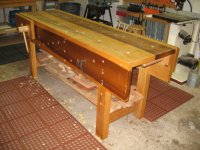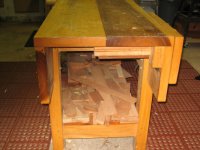ttalma
Well-known member
I am in the final stages of designing a new workbench. I am making the top from hard maple. The wood I'll be using for the top has been air dried for at least 25 years. I have two boards that are 14" wide, when dressed they will be about 1 3/4" thick. I am planning on cutting them down to 12" wide and edge gluing them together. they are flatsawn pieces.
I my design takes into account the expansion and contraction of the boards, but I am more worried about them staying flat. I have seen old benches where wide boards, even a single wide board was used for the top. Does anyone use a bench where wide boards are used for the top? are there any problems with cupping etc.
The design has 4 battons along the bottom for mounting to the base. I planed on lag bolting these to the top to help keep it flat.
I have also considered resawing these boards and jointing them to make a strip style top. but I am not sure if it's necessary.
I my design takes into account the expansion and contraction of the boards, but I am more worried about them staying flat. I have seen old benches where wide boards, even a single wide board was used for the top. Does anyone use a bench where wide boards are used for the top? are there any problems with cupping etc.
The design has 4 battons along the bottom for mounting to the base. I planed on lag bolting these to the top to help keep it flat.
I have also considered resawing these boards and jointing them to make a strip style top. but I am not sure if it's necessary.


